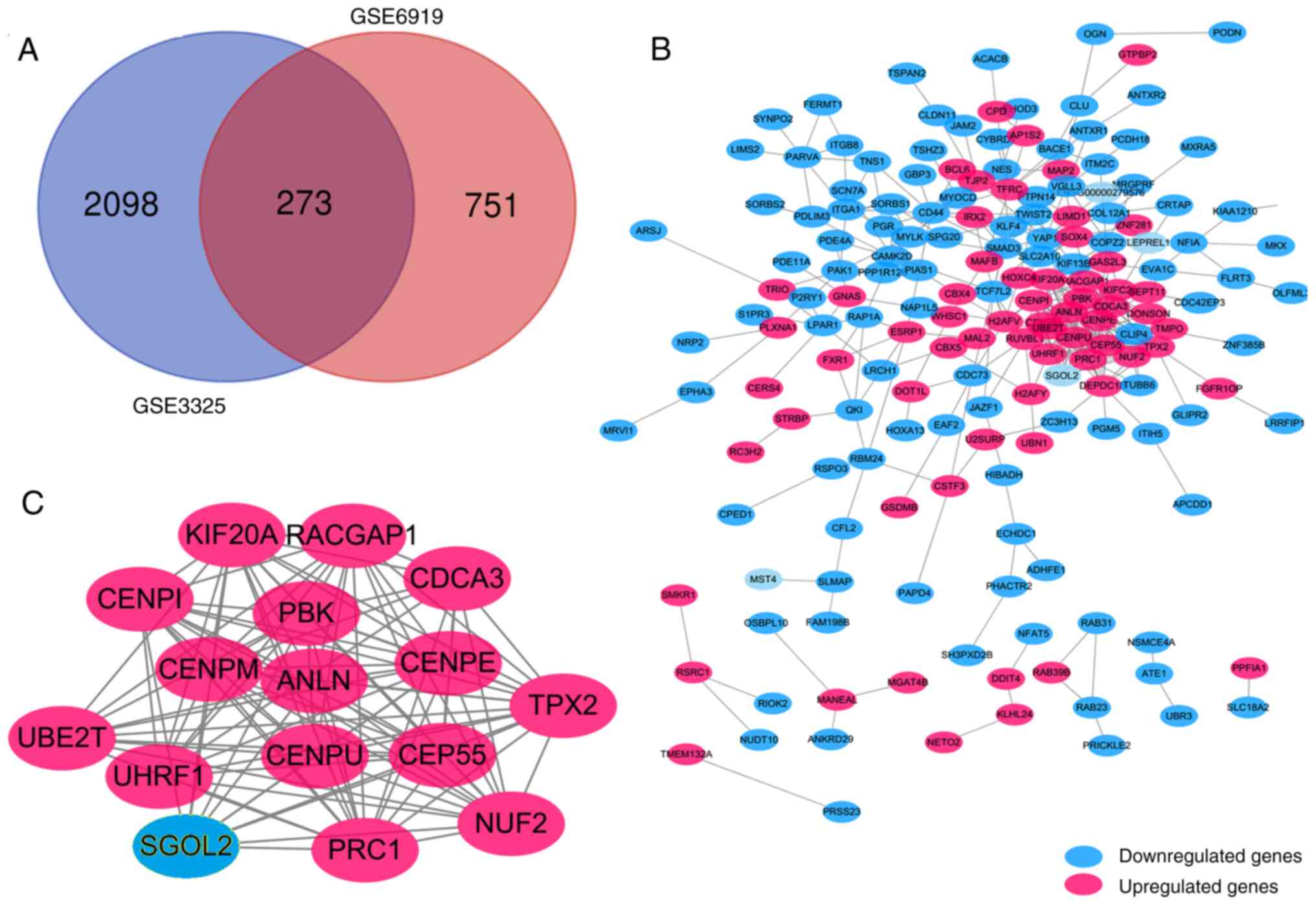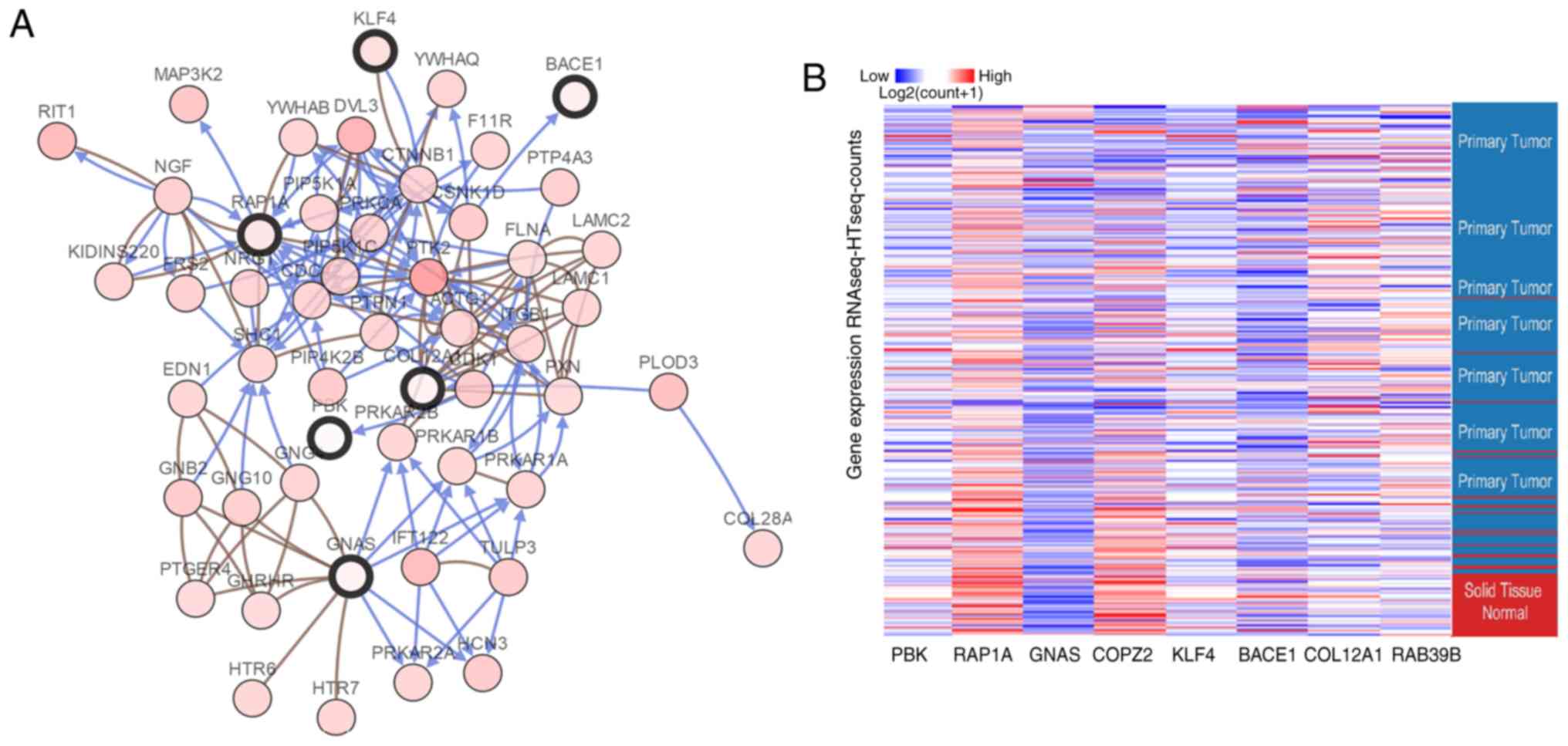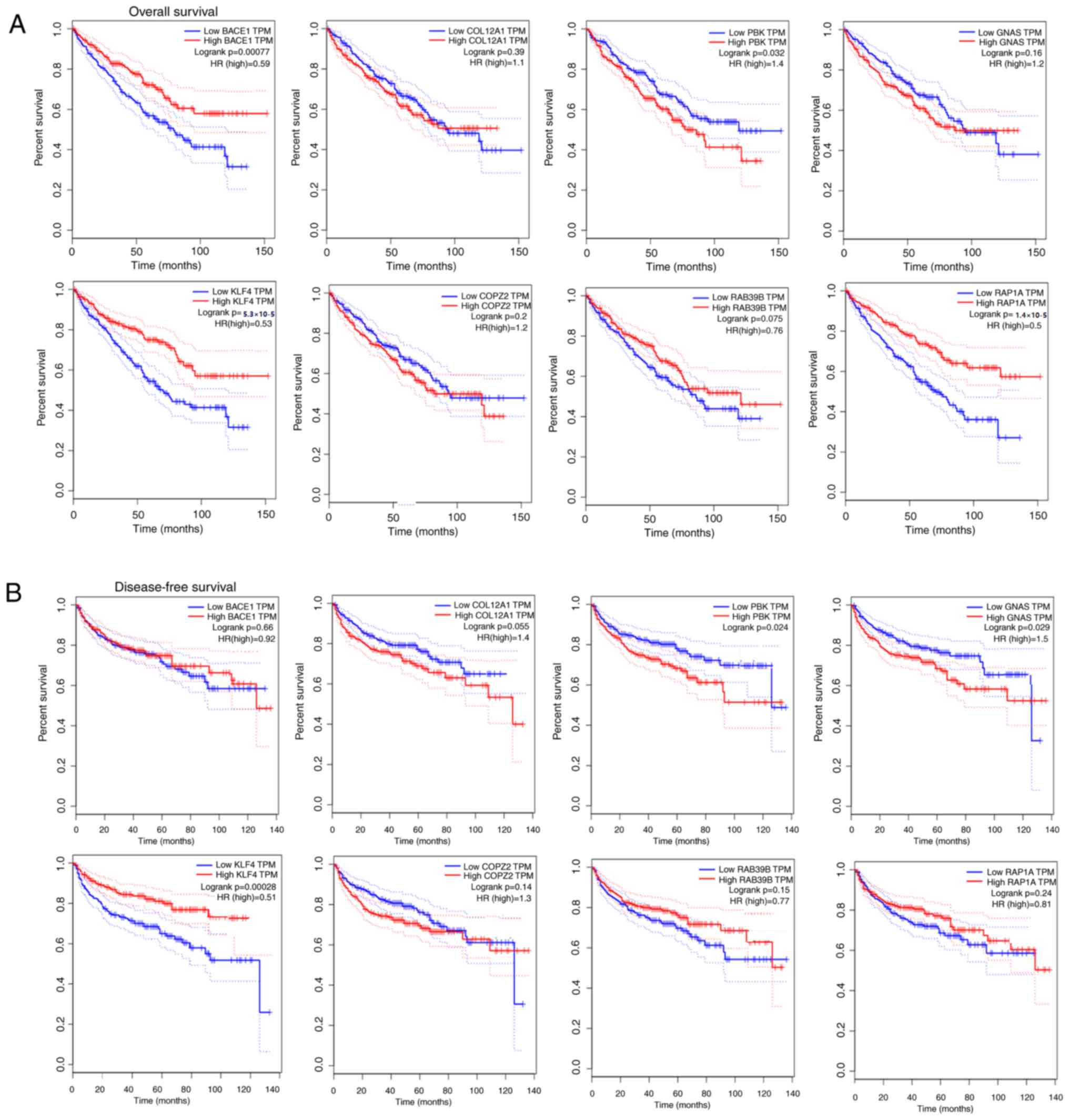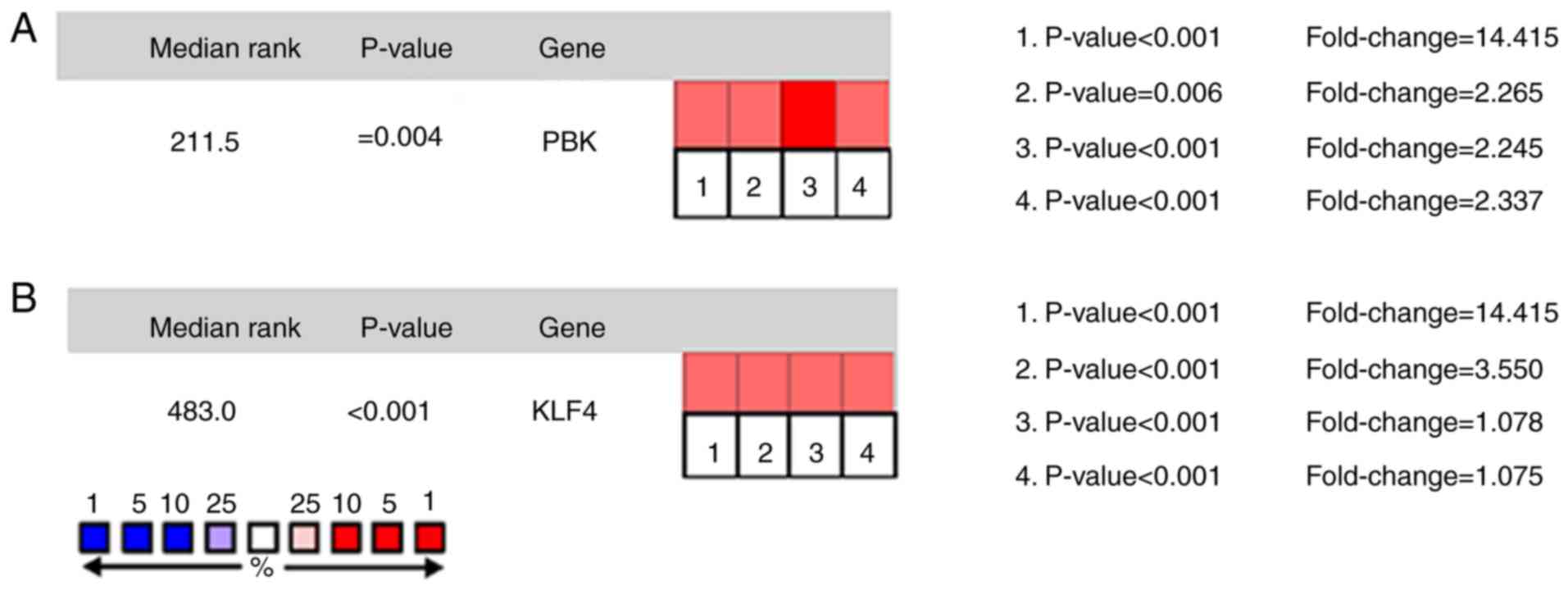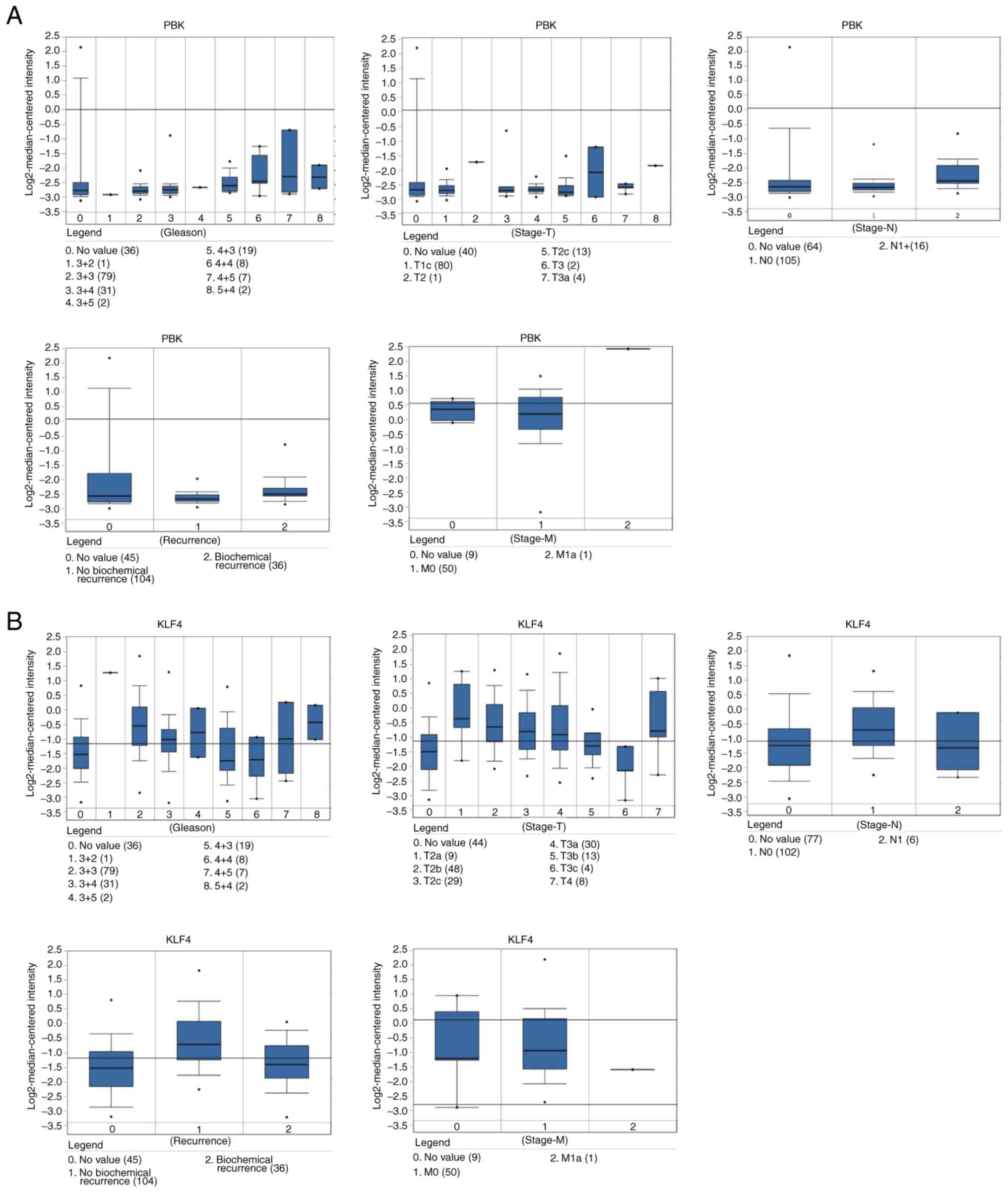Screening and identification of key biomarkers in prostate cancer using bioinformatics
- Authors:
- Published online on: November 6, 2019 https://doi.org/10.3892/mmr.2019.10799
- Pages: 311-319
-
Copyright: © Li et al. This is an open access article distributed under the terms of Creative Commons Attribution License.
Abstract
Introduction
Prostate cancer (PCa) is the second most common type of cancer among men globally, and constitutes ~15% of all cancer diagnoses worldwide (1). Digital rectal examination, measurement of the serum level of prostate specific antigen (PSA) and biopsy from a prostate transrectal ultrasonography are the most common diagnostic tools for PCa (2). Additionally, with advances in genetic analysis, alterations have been identified in a number of gene regions in patients with PCa, including prostate antigen 3, androgen-dependent transmembrane serine 2 and S-transferase P1 (3–5). However, genetic analysis exhibits a low specificity and can increase the number of unnecessary biopsies performed without reducing patient mortality (6). Previous studies have associated the tribbles pseudokinase 1 gene with the development of a number of tumors, including colorectal leukemia and hepatocellular cancers (7–9). It has been shown that transmembrane protease, serine 2:ETS-related gene (TMPRSS2:ERG) fusion is associated with diagnosing PCa in urine samples and DNA-based molecular templates (10). However, due to the lack of effective diagnostic methods during the early stages of the disease, the mortality rate of PCa remains high (10). Therefore, it is crucial to understand the molecular mechanisms associated with PCa carcinogenesis, proliferation and recurrence.
Microarray technology and bioinformatics analysis led to the identification of 273 differentially expressed genes (DEGs) and functional pathways in the carcinogenesis and progression of PCa. In the current study, two mRNA microarray datasets from Gene Expression Omnibus (GEO) were analyzed to identify DEGs between PCa tissues and non-cancerous tissues. Subsequently, the molecular mechanisms of PCa carcinogenesis and progression were investigated using Gene Ontology (GO), Kyoto Encyclopedia of Genes and Genomes (KEGG) pathway enrichment analysis and protein-protein interaction (PPI) network analyses. In conclusion, a total of 273 DEGs and 8 hub genes were identified in the current study, and these genes may be candidate biomarkers for PCa.
Materials and methods
Database
GEO (http://www.ncbi.nlm.nih.gov/geo) (11) is a public functional genomics database. GSE3325 (12) and GSE6919 (13) were downloaded from GEO (Affymetrix Human Genome U133 Plus 2.0 Array). The GSE3325 dataset contained 12 PCa tissue samples and 12 non-cancerous samples. GSE6919 contained 8 PCa samples and 8 non-cancerous samples.
Identification of DEGs
The Affy package (version 1.52.0) (14) was used to preprocess the raw expression data in the R statistical software (R ×64 3.5.3; http://cran.r-project.org). DEGs were subsequently identified between PCa and normal samples using the limma (version 3.34.7) package of the R statistical software (https://bioconductor.org/packages/release/bioc/html/limma.html). DEGs with log2FC >1 and P<0.01 were selected in the microarray data.
Enrichment analysis of DEGs
The Database for Annotation, Visualization and Integrated Discovery (DAVID; version 6.7; http://david.ncifcrf.gov) (15), which provides functional annotation information of genes and proteins, was used to perform DEG analysis of KEGG pathway enrichment (16) and GO annotation (17). P<0.05 was set as the threshold value.
Module analysis and construction of the PPI network
The Search Tool for the Retrieval of Interacting Genes (version 10.0; http://string-db.org) (18), which offers comprehensive information on PPIs, was used to create the PPI network. The molecular interaction networks were visualized using Cytoscape (version 3.4.0; http://cytoscape.org/) (19). The Molecular Complex Detection (MCODE) (version 1.4.2) of Cytoscape was used to identify densely connected regions (20). The PPI networks were visualized using Cytoscape software. The hub genes and the most significant module in the PPI networks were identified using MCODE.
Hub genes selection and analysis
The hub genes were selected and their co-expression genes were analyzed using cBioPortal (http://www.cbioportal.org) (21). Hierarchical clustering of hub genes was constructed using the University of California, Santa Cruz Cancer Browser (http://genome-cancer.ucsc.edu) (22). The overall survival and disease-free survival analyses of hub genes (the cutoff was the median expression value) were performed using Kaplan-Meier analysis in cBioPortal. The hazard ratio (HR) with 95% confidence intervals and log-rank P-value was also computed. The expression of PDZ binding kinase (PBK) and Krüppel-like factor 4 (KLF4) in cancer tissues were analyzed and presented using the online database Serial Analysis of Gene Expression (SAGE; http://www.ncbi.nlm.nih.gov/SAGE) (23). The relationship between expression patterns and tumor-node-metastasis (TNM) stage, Gleason grade and recurrence status were analyzed using the online database Oncomine (http://www.oncomine.com) (24).
Results
Identification of DEGs in PCa
After standardization of the microarray results, a total of 1,024 DEGs in GSE6919 and 2,371 DEGs in GSE3325 were identified. The overlap between the 2 datasets contained 273 genes, as presented in Fig. 1A, consisting of 173 downregulated genes and 100 upregulated genes in PCa tissues.
PPI network and module analysis
The PPI network of DEGs (Fig. 1B) and the most significant module were identified using Cytoscape (Fig. 1C). The functional analyses of DEGs demonstrated that genes in this module were mainly enriched in nucleotide binding, small molecule binding, focal adhesion and the regulation of the actin cytoskeleton (Table I).
Functional enrichment analyses of DEGs
Functional and pathway enrichment analyses of DEGs were performed using DAVID. GO analysis revealed that the biological processes of DEGs were significantly enriched in cell adhesion, negative regulation of cell proliferation, cell division and extracellular matrix organization (Table II). Molecular functions of DEGs were enriched in protein binding, GTP binding, mannose-binding, chromatin binding and chromatin binding (Table II). Cell components enriched with DEGs included the nucleus, cytoplasm, perinuclear region of the cytoplasm and focal adhesion (Table II). KEGG pathway analysis revealed that DEGs were mainly enriched in focal adhesion, regulation of the actin cytoskeleton, tight junction, coagulation cascades and gap junctions.
Analyses of the 8 hub genes
In the present study, a total of 8 hub genes were identified and these hub genes were presented in Table III. The criteria for selection were as follows: MCODE scores >5, degree cut-off=2, node score cut-off=0.2, Max depth=100 and k-score=2. Among the 8 genes, PBK, RAP1A, GNAS and RAB39B were upregulated, while COPZ2, KLF4, BACE1 and COL12A1 were downregulated A network of the hub genes and their co-expression genes were analyzed using the cBioPortal online platform (Fig. 2A). Hierarchical clustering demonstrated that the hub genes could differentiate PCa samples from noncancerous samples (Fig. 2B). Subsequently, the overall survival analysis of the hub genes was performed using a Kaplan-Meier curve analysis. Patients with PCa and PBK, RAP1A, GNAS, coatomer protein complex subunit ζ 2 (COPZ2), β-secretase 1 (BACE1) and collagen type XII α-1 Chain (COL12A1) upregulation demonstrated decreased overall survival (Fig. 3A). Patients with PCa and PBK, RAP1A, GNAS, COPZ2, BACE1 and COL12A1 upregulation exhibited decreased disease-free survival (Fig. 3B). Additionally, RAB39B and KLF4 upregulation was associated with increased overall survival and disease-free survival. Based on the above survival analysis, PBK and KLF4 were identified to serve important roles in the carcinogenesis or progression of PCa. Oncomine analysis of cancer and normal tissue revealed that PBK and KLF4 were significantly overexpressed in PCa in the different datasets (Fig. 4A and B). In the Taylor prostate of Oncomine dataset, the increased mRNA levels of PBK were associated with TNM stage, Gleason grade and recurrence status (Fig. 5A). In the Tatulippe prostate of Oncomine dataset, decreased KLF4 mRNA levels were associated with TNM stage, Gleason grade and recurrence status (Fig. 5A and B). PBK gene expression in metastatic tissue was higher compared with primary tumor and solid tissue normal via Oncomine (Fig. 6).
Discussion
Previous studies have demonstrated that the TMPRSS2:ERG fusion is significantly associated with the diagnosis of PCa (25–27). Promoter hypermethylation and downregulated expression of glutathione peroxidase 3 have been observed in a variety of cancer types, including thyroid cancer, hepatocellular carcinoma and PCa (10,26,27). Yu et al (28) identified an association between Piwi-like protein 2 (PIWIL2) gene expression and metastatic PCa. Potential markers for use in the diagnosis and treatment of PCa, which exhibit high efficiency, are urgently required. To increase understanding of the molecular mechanisms of candidate genes, GO, KEGG and PPI analyses were performed. In the current study, the epigenetic and genetic mechanisms in PCa were assessed using microarray technology.
A total of two mRNA microarray datasets were selected. A total of 273 DEGs were identified, including 173 downregulated genes and 100 upregulated genes. The interactions of DEGs were investigated using GO and KEGG analyses. DEGs were found to be enriched in focal adhesion, regulation of the actin cytoskeleton, tight junctions, coagulation cascades and gap junctions. However, other studies (29,30) have demonstrated that DEGs were enriched in a number of functional terms, including cellular response to bone morphogenetic protein (BMP) stimulus, response to BMP, extracellular region and pathways that are associated with transforming growth factor-β signaling. GO enrichment analysis revealed that changes in the most significant modules were enriched in nucleotide binding, nucleoside phosphate binding, small molecule binding and cytoskeletal protein binding, while changes in KEGG were mainly enriched in focal adhesion and regulation of the actin cytoskeleton.
A total of 8 DEGs were selected as hub genes. The criteria for selection were as follows: MCODE scores >5, degree cut-off=2, node score cut-off=0.2, Max depth=100 and k-score=2. Among the 8 genes, PBK, RAP1A, GNAS and RAB39B were upregulated, while COPZ2, KLF4, BACE1 and COL12A1 were downregulated. PBK and KLF4 were identified to be important genes in the present study. PBK is highly homologous to mitogen-activated protein kinase (31,32). By virtue of target utilization, PBK has been revealed to influence growth and differentiation (33–36). PBK is expressed in the outer cell layer of seminiferous tubules in primary spermatocytes (37), and is often increased in a number of human cancer types from different tissue sources (38,39). However, the function of PBK has not yet been fully determined. In a previous study, the immunohistochemical expression of PBK/T-LAK cell-originated protein kinase (TOPK) was revealed to be significantly associated with human bladder cancer, and was identified as a novel diagnostic biomarker for this disease (40). In the present study, the PPI network revealed that PBK directly interacted with cyclin-dependent kinase 1, Rac GTPase-activating protein 1, baculoviral IAP repeat containing 5 and protein regulator of cytokinesis 1, indicating a key role for PBK in PCa. The expression of PBK was subsequently assessed. Gene upregulation in PBK were associated with reductions in overall and disease free survival. Additionally, the KLF4 upregulation was significantly associated with increased overall survival and disease-free survival.
High levels of PBK were associated with advanced stages, Gleason score ≥8 and recurrence (41). Additionally, PBK was significantly increased in PCa (P=0.001), and the expression was higher in the Gleason high-scoring group compared with the low-scoring group (P=0.001) (41). PBK, Gleason score and pathological stage are independent predictors of PCa recurrence, and PBK has been indicated to be significantly associated with survival of no biochemical recurrence (42). As an important mitotic kinase, PBK has been reported to exhibit a close association with patient clinical characteristics (43). The current study indicated that higher mRNA levels of PBK were associated with TNM stage, Gleason grade and recurrence status, demonstrating the vital roles of PBK in the carcinogenesis and progression of PCa. PBK gene expression in metastatic tissue was higher compared with primary tumor and solid tissue normal tissue, and PBK has been indicated to serve an important role in mitosis (43). PBK expression and phosphorylation are significantly increased during cell mitosis (44). Previously, a knock-out study of TOPK revealed that PBK can affect spindle formation (36). When PBK is inhibited during mitosis, the spindle (especially the central part) in mitosis and the subsequent cells become blurred (44). The pulp division cannot be completed smoothly and the cells will subsequently split out of the multinucleated cells. Therefore, PBK has been identified to be associated with the regulation of proliferation and cell cycle changes in malignant tumor cells, and has also been revealed to promote tumor cell transformation (33).
KLF4 is a member of the Krüppel-like zinc finger transcription factor family, which serves a role in regulating important processes, including cell proliferation, differentiation and embryo development (36). They are also associated with numerous human cancer types, including gastrointestinal, bladder and lung cancers (33,36,45). A number of KLF4 targeting genes are also biomarker transcription factors in the endothelial-mesenchymal transition (EMT) process (45). Additionally, a previous study indicated that the expression of E-cadherin and α-catenin in the KLF4 overexpression treatment group was significantly higher compared with the control group, while the mesenchymal cell marker vimentin and the expression of vascular endothelial growth was significantly lower compared with the control group (46). It has been shown that KLF4 protein is negatively associated with clinical stages in patients with meningioma, and it promotes or inhibits the EMT process by acting on transcription factors (46). The transcription factor KLF4 in PCa cells promotes the migration and invasion of EMT and tumor cells in vitro (47). These results are consistent with the results of the current study, which indicated that lower mRNA levels of PBK were associated with TNM stage, Gleason grade and recurrence status. KLF4 was also indicated to be downregulated in PCa tissue with metastases. Furthermore, the stable knockdown of KLF4 expression in PCa cells has been identified to upregulate the expression of epithelial-related gene E-cadherin and downregulate the expression of a variety of mesenchymal-associated genes in vitro, and has been revealed to serve a role in the inhibition of tumor cell migration and invasion (48). Katz et al (49) demonstrated that the expression of KLF4 in tumor tissues was significantly decreased in patients with PCa in the USA, and that the upregulation of KLF4 inhibited tumor migration and invasion. Ghaleb et al (50) identified a positive feedback loop control between KLF4 and the androgen receptor, and revealed that the inhibition of KLF4 expression in prostatic adenocarcinoma cells can inhibit the occurrence of EMT in vitro and serve a role in inhibiting tumor cell migration and invasion. It has also been indicated that KLF4 can serve the role as an oncogene or tumor suppressor gene in a number of cellular environments (50).
In conclusion, a total of 273 DEGs and 8 hub genes were identified as potential novel diagnostic biomarkers for PCa. The current study identified 2 genes associated with PCa progression, including PBK and KLF4. However, the current study is performed based on bioinformatics methods and no experiments were performed to confirm these conclusions. Therefore, further experimental study is required to support the results gained from the current analysis.
Acknowledgements
Not applicable.
Funding
The present study was supported by Special Projects for Key R&D and Promotion (Science and Technology Breakthrough) of Henan Department of Science and Technology (grant no. 192102310109).
Availability of data and materials
The datasets used and/or analyzed during the present study are available from the corresponding author on reasonable request.
Authors' contributions
SL, WBX and JH conceived and designed the study, and the experiments were performed by SL. SL, JH and WBX analyzed the data and wrote the manuscript. The original text was drafted and modified by SL and WBX. All authors read and approved the final manuscript.
Ethics approval and consent to participate
Not applicable.
Patient consent for publication
Not applicable.
Competing interests
The authors declare that they have no competing interests.
References
|
Ferlay J, Soerjomataram I, Dikshit R, Eser S, Mathers C, Rebelo M, Parkin DM, Forman D and Bray F: Cancer incidence and mortality worldwide: sources, methods and major patterns in GLOBOCAN 2012. Int J Cancer. 136:359–386. 2015. View Article : Google Scholar | |
|
Roobol MJ, Steyerberg EW, Kranse R, Wolters T, van den Bergh RC, Bangma CH and Schröder FH: A risk-based strategy improves prostatespecific antigen-driven detection of prostate cancer. Eur Urol. 57:79–85. 2010. View Article : Google Scholar : PubMed/NCBI | |
|
Bussemakers MJ, van Bokhoven A, Verhaegh GW, Smit FP, Karthaus HF, Schalken JA, Debruyne FM, Ru N and Isaacs WB: DD3: A new prostate-specific gene, highly overexpressed in prostate cancer. Cancer Res. 59:5975–5979. 1999.PubMed/NCBI | |
|
Tomlins SA, Rhodes DR, Perner S, Dhanasekaran SM, Mehra R, Sun XW, Varambally S, Cao X, Tchinda J, Kuefer R, et al: Recurrent fusion of TMPRSS2 and ETS transcription factor genes in prostate cancer. Science. 310:644–648. 2005. View Article : Google Scholar : PubMed/NCBI | |
|
Harden SV, Sanderson H, Goodman SN, Partin AA, Walsh PC, Epstein JI and Sidransky D: Quantitative GSTP1 methylation and the detection of prostate adenocarcinoma in sextant biopsies. J Natl Cancer Inst. 95:1634–1637. 2003. View Article : Google Scholar : PubMed/NCBI | |
|
Ilic D, Neuberger MM, Djulbegovic M and Dahm P: Screening for prostate cancer. Cochrane Database Syst Rev. CD0047202013.PubMed/NCBI | |
|
Wang Y, Wu N, Pang B, Tong D, Sun D, Sun H, Zhang C, Sun W, Meng X, Bai J, et al: TRIB1 promotes colorectal cancer cell migration and invasion through activation MMP-2 via FAK/Src and ERK pathways. Oncotarget. 8:47931–47942. 2017.PubMed/NCBI | |
|
Yoshida A, Kato JY, Nakamae I and Yoneda-Kato N: COP1 targets C/EBPα for degradation and induces acute myeloid leukemia via Trib1. Blood. 122:1750–1760. 2013. View Article : Google Scholar : PubMed/NCBI | |
|
Ye Y, Wang G, Wang G, Zhuang J, He S, Song Y, Ni J, Xia W and Wang J: The oncogenic role of tribbles 1 in hepatocellular carcinoma is mediated by a feedback loop involving microRNA-23a and p53. Front Physiol. 8:7892017. View Article : Google Scholar : PubMed/NCBI | |
|
García-Perdomo HA, Chaves MJ, Osorio JC and Sanchez A: Association between TMPRSS2:ERG fusion gene and the prostate cancer: Systematic review and meta-analysis. Cent European J Urol. 71:410–419. 2018.PubMed/NCBI | |
|
Edgar R, Domrachev M and Lash AE: Gene expression omnibus: NCBI gene expression and hybridization array data repository. Nucleic Acids Res. 30:207–210. 2002. View Article : Google Scholar : PubMed/NCBI | |
|
Varambally S, Yu J, Laxman B, Rhodes DR, Mehra R, Tomlins SA, Shah RB, Chandran U, Monzon FA, Becich MJ, et al: Integrative genomic and proteomic analysis of prostate cancer reveals signatures of metastatic progression. Cancer Cell. 8:393–406. 2005. View Article : Google Scholar : PubMed/NCBI | |
|
Yu YP, Landsittel D, Jing L, Nelson J, Ren B, Liu L, McDonald C, Thomas R, Dhir R, Finkelstein S, et al: Gene expression alterations in prostate cancer predicting tumor aggression and preceding development of malignancy. J Clin Oncol. 22:2790–2799. 2004. View Article : Google Scholar : PubMed/NCBI | |
|
Gautier L, Cope L, Bolstad BM and Irizarry RA: affy-analysis of Affymetrix GeneChip data at the probe level. Bioinformatics. 20:307–315. 2004. View Article : Google Scholar : PubMed/NCBI | |
|
Huang DW, Sherman BT, Tan Q, Collins JR, Alvord WG, Roayaei J, Stephens R, Baseler MW, Lane HC and Lempicki RA: The DAVID gene functional classification tool: A novel biological module-centric algorithm to functionally analyze large gene lists. Genome Biol. 8:R1832007. View Article : Google Scholar : PubMed/NCBI | |
|
Kanehisa M: The KEGG database. Novartis Found Symp. 247:91-103, 119–128, 244–252. 2002. | |
|
Ashburner M, Ball CA, Blake JA, Botstein D, Butler H, Cherry JM, Davis AP, Dolinski K, Dwight SS, Eppig JT, et al: Gene ontology: Tool for the unification of biology. The gene ontology consortium. Nat Genet. 25:25–29. 2000. View Article : Google Scholar : PubMed/NCBI | |
|
Smoot ME, Ono K, Ruscheinski J, Wang PL and Ideker T: Cytoscape 2.8: New features for data integration and network visualization. Bioinformatics. 27:431–432. 2011. View Article : Google Scholar : PubMed/NCBI | |
|
Bandettini WP, Kellman P, Mancini C, Booker OJ, Vasu S, Leung SW, Wilson JR, Shanbhag SM, Chen MY and Arai AE: MultiContrast delayed enhancement (MCODE) improves detection of subendocardial myocardial infarction by late gadolinium enhancement cardiovascular magnetic resonance: A clinical validation study. J Cardiovasc Magn Reson. 14:832012. View Article : Google Scholar : PubMed/NCBI | |
|
Gao J, Aksoy BA, Dogrusoz U, Dresdner G, Gross B, Sumer SO, Sun Y, Jacobsen A, Sinha R, Larsson E, et al: Integrative analysis of complex cancer genomics and clinical profiles using the cBioPortal. Sci Signal. 6:pl12013. View Article : Google Scholar : PubMed/NCBI | |
|
Cerami E, Gao J, Dogrusoz U, Gross BE, Sumer SO, Aksoy BA, Jacobsen A, Byrne CJ, Heuer ML, Larsson E, et al: The cBio cancer genomics portal: An open platform for exploring multidimensional cancer genomics data. Cancer Discov. 2:401–404. 2012. View Article : Google Scholar : PubMed/NCBI | |
|
Kent WJ, Sugnet CW, Furey TS, Roskin KM, Pringle TH, Zahler AM and Haussler D: The human genome browser at UCSC. Genome Res. 12:996–1006. 2002. View Article : Google Scholar : PubMed/NCBI | |
|
Chen X, Cheung ST, So S, Fan ST, Barry C, Higgins J, Lai KM, Ji J, Dudoit S, Ng IO, et al: Gene expression patterns in human liver cancers. Mol Biol Cell. 13:1929–1939. 2002. View Article : Google Scholar : PubMed/NCBI | |
|
Roessler S, Jia HL, Budhu A, Forgues M, Ye QH, Lee JS, Thorgeirsson SS, Sun Z, Tang ZY, Qin LX and Wang XW: A unique metastasis gene signature enables prediction of tumor relapse in early-stage hepatocellular carcinoma patients. Cancer Res. 70:10202–10212. 2010. View Article : Google Scholar : PubMed/NCBI | |
|
Wurmbach E, Chen YB, Khitrov G, Zhang W, Roayaie S, Schwartz M, Fiel I, Thung S, Mazzaferro V, Bruix J, et al: Genome-wide molecular profiles of HCV-induced dysplasia and hepatocellular carcinoma. Hepatology. 45:938–947. 2007. View Article : Google Scholar : PubMed/NCBI | |
|
Zhao H, Li J, Li X, Han C, Zhang Y, Zheng L and Guo M: Silencing GPX3 expression promotes tumor metastasis in human thyroid cancer. Curr Protein Pept Sci. 16:316–321. 2015. View Article : Google Scholar : PubMed/NCBI | |
|
Cao S, Yan B, Lu Y, Zhang G, Li J, Zhai W, Guo W and Zhang S: Methylation of promoter and expression silencing of GPX3 gene in hepatocellular carcinoma tissue. Clin Res Hepatol Gastroenterol. 39:198–204. 2015. View Article : Google Scholar : PubMed/NCBI | |
|
Yu YP, Yu G, Tseng G, Cieply K, Nelson J, Defrances M, Zarnegar R, Michalopoulos G and Luo JH: Glutathione peroxidase 3, deleted or methylated in prostate cancer, suppresses prostate cancer growth and metastasis. Cancer Res. 67:8043–8050. 2007. View Article : Google Scholar : PubMed/NCBI | |
|
Edelman GM and Crossin KL: Cell adhesion molecules: Implications for a molecular histology. Annu Rev Biochem. 60:155–190. 1991. View Article : Google Scholar : PubMed/NCBI | |
|
Fang E, Zhang X, Wang Q and Wang D: Identification of prostate cancer hub genes and therapeutic agents using bioinformatics approach. Cancer Biomark. 20:553–561. 2017. View Article : Google Scholar : PubMed/NCBI | |
|
Yang Y, Zhang X, Song D and Wei J: Piwil2 modulates the invasion and metastasis of prostate cancer by regulating the expression of matrix meta lloproteinase-9 and epithelial-mesenchymal transitions. Oncol Lett. 10:1735–1740. 2015. View Article : Google Scholar : PubMed/NCBI | |
|
Gaudet S, Branton D and Lue RA: Characterization of PDZ binding kinase, a mitotic kinase. Proc Natl Acad Sci USA. 97:5167–5172. 2000. View Article : Google Scholar : PubMed/NCBI | |
|
Abe Y, Matsumoto S, Kito K and Ueda N: Cloning and expression of a novel MAPKK-like protein kinase, lymphokine-activated killer T-cell-originated protein kinase, specifically expressed in the testis and activated lymphoid cells. J Biol Chem. 275:21525–21531. 2000. View Article : Google Scholar : PubMed/NCBI | |
|
Zhang C, Habets G and Bollag G: Interrogating the kinome. Nat Biotechnol. 29:981–983. 2011. View Article : Google Scholar : PubMed/NCBI | |
|
Lu Y, Muller M, Smith D, Dutta B, Komurov K, Iadevaia S, Ruths D, Tseng JT, Yu S, Yu Q, et al: Kinome siRNA-phosphoproteomic screen identifies networks regulating AKT signaling. Oncogene. 30:4567–4577. 2011. View Article : Google Scholar : PubMed/NCBI | |
|
Matsumoto S, Abe Y, Fujibuchi T, Takeuchi T, Kito K, Ueda N, Shigemoto K and Gyo K: Characterization of a MAPKK-like protein kinase TOPK. Biochem Biophys Res Commun. 325:997–1004. 2004. View Article : Google Scholar : PubMed/NCBI | |
|
Park JH, Nishidate T, Nakamura Y and Katagiri T: Critical roles of T-LAK cell-originated protein kinase in cytokinesis. Cancer Sci. 101:403–411. 2010. View Article : Google Scholar : PubMed/NCBI | |
|
Fujibuchi T, Abe Y, Takeuchi T, Ueda N, Shigemoto K, Yamamoto H and Kito K: Expression and phosphorylation of TOPK during spermatogenesis. Dev Growth Differ. 47:637–644. 2005. View Article : Google Scholar : PubMed/NCBI | |
|
Park JH, Lin ML, Nishidate T, Nakamura Y and Katagiri T: PDZ-binding kinase/T-LAK cell-originated protein kinase, a putative cancer/testis antigen with an oncogenic activity in breast cancer. Cancer Res. 66:9186–9195. 2006. View Article : Google Scholar : PubMed/NCBI | |
|
Singh PK, Srivastava AK, Dalela D, Rath SK, Goel MM and Bhatt ML: Expression of PDZ-binding kinase/T-LAK cell-originated protein kinase (PBK/TOPK) in human urinary bladder transitional cell carcinoma. Immunobiology. 219:469–474. 2014. View Article : Google Scholar : PubMed/NCBI | |
|
Kim DJ, Li Y, Reddy K, Lee MH, Kim MO, Cho YY, Lee SY, Kim JE, Bode AM and Dong Z: Novel TOPK inhibitor HI-TOPK-032 effectively suppresses colon cancer growth. Cancer Res. 72:3060–3068. 2012. View Article : Google Scholar : PubMed/NCBI | |
|
Sun H, Zhang L, Shi C, Hu P, Yan W, Wang Z, Duan Q, Lu F, Qin L, Lu T, et al: TOPK is highly expressed in circulating tumor cells, enabling metastasis of prostate cancer. Oncotarget. 6:12392–12404. 2015. View Article : Google Scholar : PubMed/NCBI | |
|
Chen JH, Fang SM and Liang YK: Expression and clinical significance of PBK in prostate cancer tissues. Guangzhou Pharm. 48:1000–8535. 2017. | |
|
Simons-Evelyn M, Bailey-Dell K, Toretsky JA, Ross DD, Fenton R, Kalvakolanu D and Rapoport AP: PBK/TOPK is a novel mitotic kinase which isupregulated in burkitt's lymphoma and other highly proliferative malignant cells. Blood Cells Mol Dis. 27:825–829. 2001. View Article : Google Scholar : PubMed/NCBI | |
|
Simons-Evelyn M, Bailey-Dell K, Toretsky JA, Ross DD, Fenton R, Kalvakolanu D and Rapoport AP: PBK/TOPK is a novel mitotic kinase which is upregulated in Burkitt's lymphoma and other highly proliferative malignant cells. Blood Cells Mol Dis. 27:825–829. 2001. View Article : Google Scholar : PubMed/NCBI | |
|
Wei D, Gong W, Kanai M, Schlunk C, Wang L, Yao JC, Wu TT, Huang S and Xie K: Drastic down-regulation of Krüppel-like factor 4 expression is critical in human gastric cancer development and progression. Cancer Res. 65:2746–2754. 2005. View Article : Google Scholar : PubMed/NCBI | |
|
Ohnishi S, Ohnami S, Laub F, Aoki K, Suzuki K, Kanai Y, Haga K, Asaka M, Ramirez F and Yoshida T: Downregulation and growth inhibitory effect of epithelial-type Krüppel-like transcription factor KLF4, but not KLF5, in bladder cancer. Biochem Biophys Res Commun. 308:251–256. 2003. View Article : Google Scholar : PubMed/NCBI | |
|
Wei D, Kanai M, Jia Z, Le X and Xie K: Kruppel-like factor 4 induces p27Kip1 expression in and suppresses the growth and metastasis of human pancreatic cancer cells. Cancer Res. 68:4631–4639. 2008. View Article : Google Scholar : PubMed/NCBI | |
|
Katz JP, Perreault N, Goldstein BG, Lee CS, Labosky PA, Yang VW and Kaestner KH: The zinc-finger transcription factor Klf4 is required for terminal differentiation of goblet cells in the colon. Development. 129:2619–2628. 2002.PubMed/NCBI | |
|
Ghaleb AM, McConnell BB, Nandan MO, Katz JP, Kaestner KH and Yang VW: Haploinsufficiency of Krüppel-like factor 4 promotes adenomatous polyposis coli dependent intestinal tumorigenesis. Cancer Res. 67:7147–7154. 2007. View Article : Google Scholar : PubMed/NCBI |



